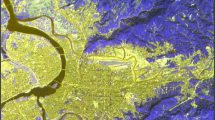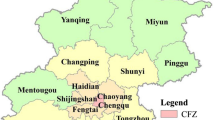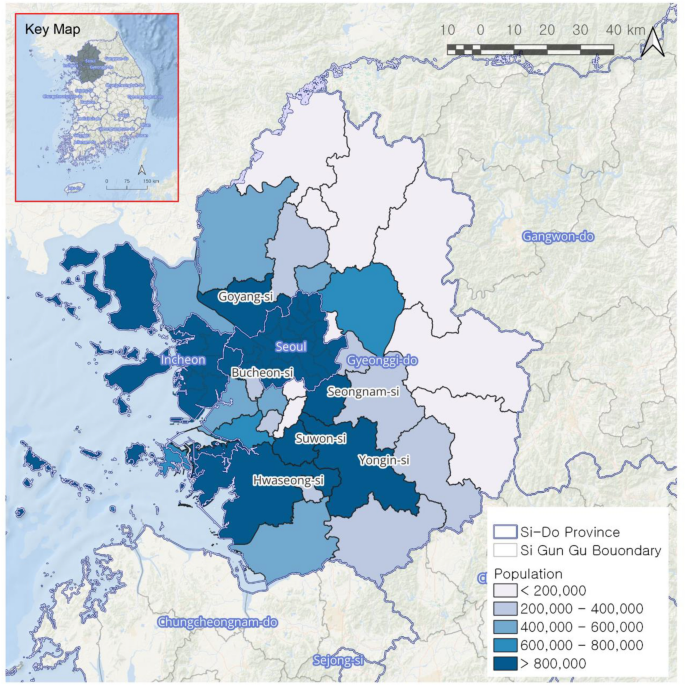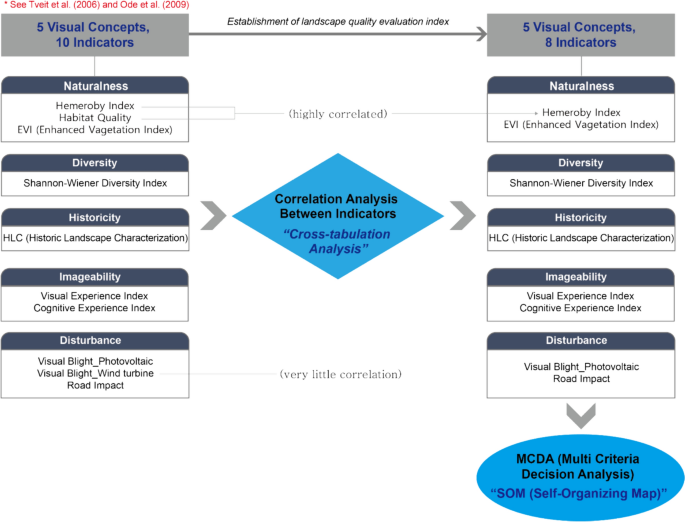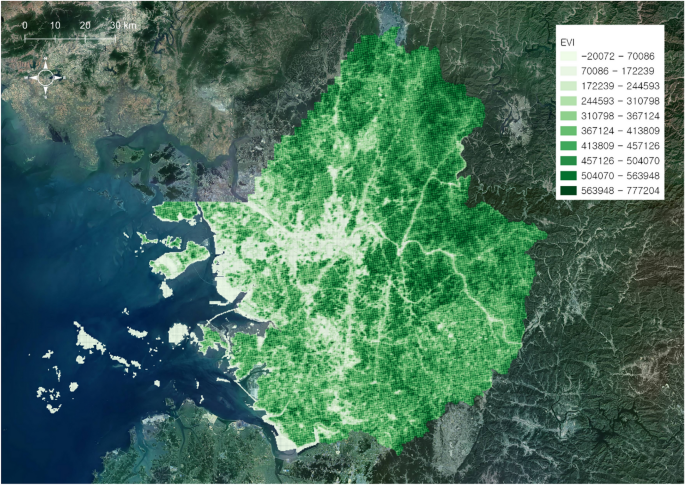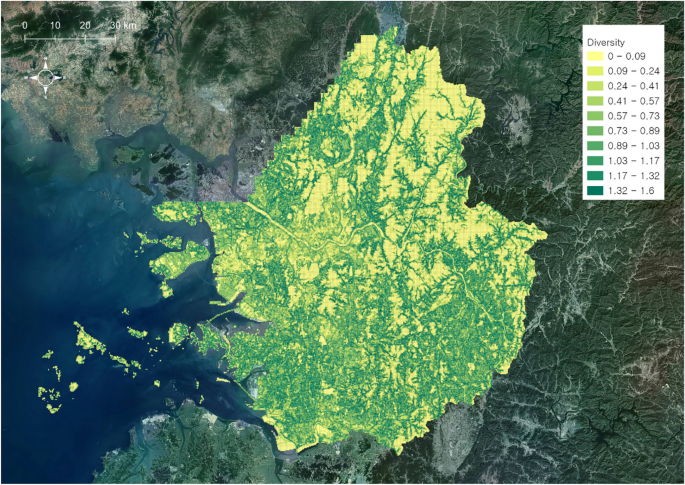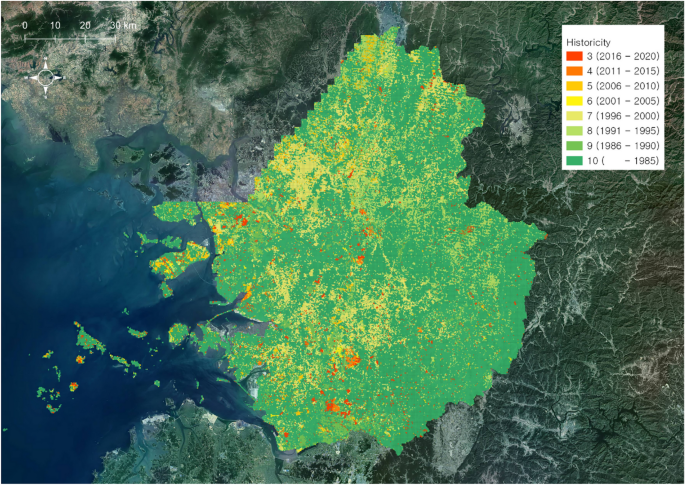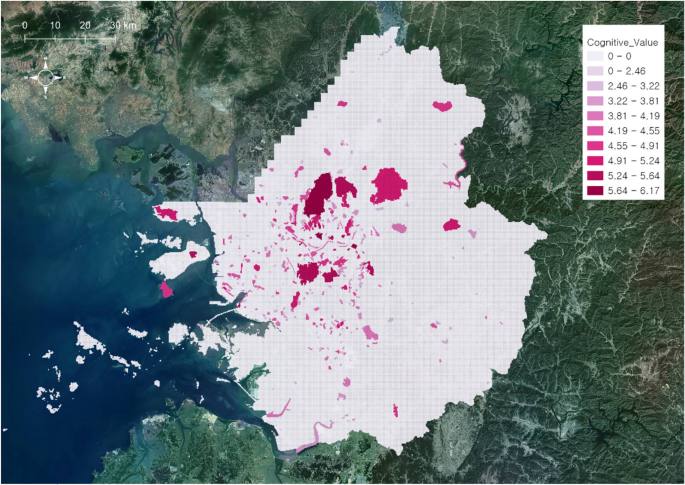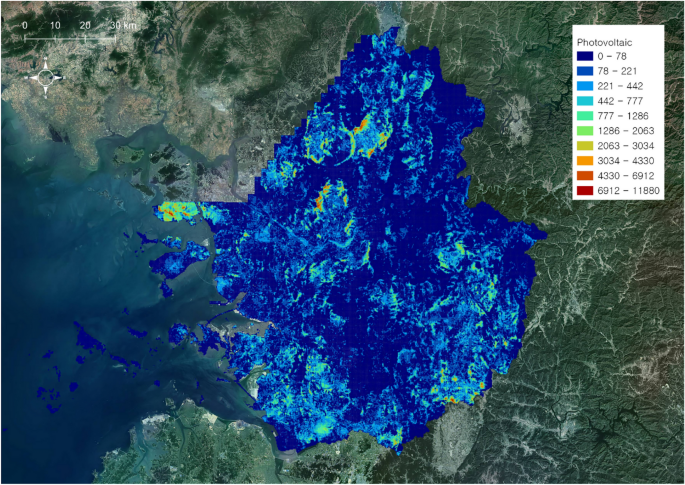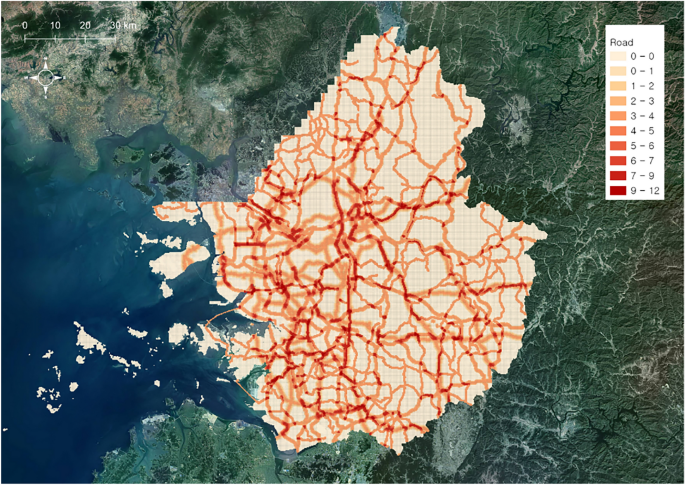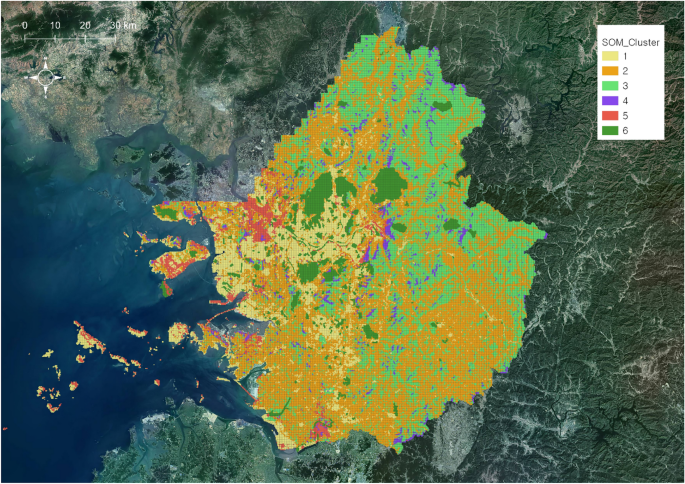Abstract
This study aimed to develop a method for assessing landscapes using environmental data and user-generated data, which are commonly employed in landscape research. It focused on the Seoul metropolitan area in South Korea, devising evaluation indicators for five key concepts: naturalness, diversity, imageability, historicity, and disturbance. These indicators were used to assess the landscapes based on each index. We employed a self-organizing map, an artificial neural network technique, to categorize the landscape units and developed eight evaluation indicators for the five key concepts, organizing the study area’s landscapes into six distinct landscape units. This study identified landscape unit types with increased vulnerability to visual blight or heightened public awareness by considering both user characteristics and environmental attributes in the metropolitan area landscapes. Finally, we discussed future tasks for appropriate landscape management based on each landscape area’s characteristics to maintain and enhance landscape quality.
Similar content being viewed by others
Explore related subjects
Find the latest articles, discoveries, and news in related topics.Avoid common mistakes on your manuscript.
Introduction
Landscape conservation contributes to protecting people’s health and enriching their quality of life beyond visual beauty. Research on the assessment of landscape perception and landscape preference began in the late 1960s (Linton 1968; Shafer 1969; Shafer and Mietz 1970). Through this, as landscape continues to be recognized as important environmental resources, there has been a growing need for quantitative methods to evaluate them. These methods have been continuously developed and introduced (Arthur et al. 1977). Despite the importance of landscape evaluation, collecting data for landscape perception and preference evaluation is challenging due to the inherent ambiguity of concept of landscape (Sevenant and Antrop 2011).
Landscape evaluation methods thus far can be classified into methods focused on the biophysical environment (Litton 1978; Koschke et al. 2012; Hermes et al. 2018) and methods evaluating people’s perceptions toward landscapes (Kaplan et al. 2006; Sevenant and Antrop 2009; Wang et al. 2016). Methodologically, evaluation of the biophysical environment has been mostly in the form of spatial analysis on environmental data using geographic information systems (GIS) or remote-sensing techniques (Sowińska-Świerkosz et al. 2020). Moreover, the evaluations of people’s awareness regarding landscapes have mostly relied on psychological surveys and statistical analyses that use landscape photos.
In landscape evaluation, it is important to consider both the physical environment and how people perceive the landscape. Although objective and quantitative evaluation is methodologically convenient, the importance of subjective evaluation cannot be overlooked (Lothian 1999). Recently, experimental studies to integrate the objective evaluation of the biophysical environment and subjective evaluation of people’s perceptions have been published. Since the early 2000s, the social ecological system (SES) has received attention as an integrated evaluation system that includes the relationship between people and nature environment. Alessa et al. (2008) have used the Public Participate GIS (PPGIS) technique to study the relationship between ecological values and the values perceived by people. Frank et al. (2013) have attempted to develop an evaluation method that integrates objective and subjective approaches using the correlation between quantitative landscape metrics evaluations of landscape diversity based on land cover maps and survey results. Vigl et al. (2017) have evaluated and mapped the landscape esthetics of forest landscapes based on the correlation between the value of the physical environment and socioeconomic statistical data (number of visitors, etc.) in an ecosystem service evaluation study. Furthermore, Kerebel et al. (2019) have developed an artificial intelligence (AI)-based probabilistic model that reflects the preferences of actual beholders by interconnecting the biophysical environment and social attributes based on surveys and have experimentally applied it.
Despite efforts to combine objective and subjective approaches in landscape evaluation, these attempts remain experimental and present some challenges in research methods. Furthermore, in social sciences, landscape beauty is also challenging, because it is a subjective concept that varies according to a person’s social context or sociodemographic characteristics, such as gender, age, or occupation (Dronova 2017).
Considering the subjective nature of social scientific approaches, how can we effectively integrate physical landscape features with human perception data in landscape assessment? This study proposes utilizing social media data to capture people's experiences of landscapes, which will allow for a more comprehensive understanding that incorporates both physical environments and social perceptions.
The study aims to develop a landscape assessment method that integrates environmental data and social media data, with a focus on user-generated data.
Social media data are gaining attention as a potential alternative approach that can integrate and evaluate both the physical environment and the perceived landscape. Social media data are produced through people’s perceptions of the physical environment or actual experiences. Tieskens et al. (2018) examined the correlation between landscape preference elements and information derived from photos shared on social media. Social media data is a useful tool for identifying and evaluating landscapes perceived and experienced by people (Cheng et al. 2019).
Recently, many studies have been conducted on the visualization of perceived environments based on various social media contents (Dunkel 2015; Tenerelli et al. 2016). For example, several analysis methods using social media data have been developed in evaluations of specific spatial objects, such as the evaluation of the Cultural Ecosystem Service (Kim and Son 2021a, b) or the categorization of national park landscapes (Lee and Son 2023).
Since landscape evaluation indicators can have different value dimensions, it is not reasonable to simply sum up the scores of the indicators to determine the overall quality of the landscape. The meaning of these indicators becomes clear in the context of the specific site’s function, use, and historical and cultural value. For instance, the presence of a main road within a landscape evaluation site can have different implications for recreation areas, national parks, and historic landscape conservation areas. Therefore, when assessing landscape quality at a regional level, it is necessary to categorize them based on landscape characteristics.
In this study, the indicators developed using environmental data, socioeconomic data, and user-generated data were categorized and mapped using a self-organizing map (SOM), which is an artificial neural network technique in landscape quality evaluation. Finally, we discuss future tasks on landscape assessment.
Materials and methods
Study area
The study area is the metropolitan area of Seoul, the capital city of South Korea. The diverse land use characteristics in the Seoul metropolitan area range from urban to rural, with particularly rapid landscape transformations occurring in the suburbs. Consequently, there is a pressing need for comprehensive landscape quality assessments and conservation efforts.
The metropolitan area spans 11,868 km2, accounting for 11.8% of the national land, and the population is approximately 260,000 (based on statistics in 2023), with 50.5% of the nation’s population residing in the metropolitan area. The administrative district is a broad metropolitan area comprising 33 districts, 28 cities, and five counties including Seoul (25 districts), Incheon (eight districts, two counties), and Gyeonggi-do (28 cities, three counties) (Fig. 1). Various landscapes of not only the city and suburbs but also agricultural, mountainous, and fishing villages are in the study area. There is a high-density urban area of Seoul located at the center of the metropolitan area toward Incheon, a coastal city along the west axis, and an axis is formed due to conurbation from Suwon to Yongin to the south of Seoul. Toward east of the study area, there are suburbs as well as mountainous and rural villages with relatively low population densities (Fig. 1).
Setting key concepts and indicators for landscape evaluation
This study conducted a landscape quality assessment by adopting five key concepts for landscape quality evaluation with reference to the studies by Tveit et al. (2006) and Ode et al. (2009), including naturalness, diversity, imageability, historicity, and disturbance, with the last one being an inverse indicator.
Naturalness is the most used index in landscape preference studies (Ode et al. 2009). Naturalness is polysemous, consisting of cognitive, visual, and ecological naturalness factors (Lee et al. 2023), and can be evaluated with different indicators.
Diversity is a tool that measures a landscape’s ecological characteristics (Fjellstad et al. 2001) as well as an index used to identify land-use characteristics (Yeh and Huang 2009). Diversity can be measured objectively by deriving the diversity index using landscape metrics and can be used to identify the correlation with landscape esthetics evaluation (Frank et al. 2013).
The historicity index of landscapes illustrates the continuity of a landscape, linking its evolution from the past to the present (Scazzosi 2004). A landscape is an area formed by the relationship between people and nature environment, and through the index of time depth (Sarlöv Herlin 2016), land that remains unchanged for a long time is considered to have historic landscape value. In regional landscape assessments, historicity can be evaluated by examining the extent to which a landscape remains unchanged and retains a distinct past or historical context.
Imageability is a concept of spatial environmental perception. Imageability and legibility, created through the actions of visitors and users, become indicators that evaluate a favorable environment (Lynch 1964). Imageability, which indicates the image of the landscape, is highly related to the public’s landscape preference or landscape esthetics evaluation. Recent studies using social media data determine such data as user experience data and evaluate landscape preference (Foltête et al. 2020; Tieskens et al. 2018) or landscape esthetics (Figueroa-Alfaro and Tang 2017) based on frequencies within the data. Specifically, this study assessed landscape imageability by dividing it into two components: the visual experience index, based on photo data from an individual’s observation point, and the cognitive experience index, determined by the frequency of exposure in social blog posts according to social media data attributes. Finally, this study examined visual blight arising from the presence of photovoltaic (PV) and wind turbine energy plant facilities, as well as the impact of roads, which have recently been identified as major concerns in regional landscape management in Korea.
Initially, this study employed 10 indicators, considering the usability of environmental and user-generated data for the five key concepts of landscape quality assessment in the area. Upon examining the correlations among these indicators, the analysis ultimately focused on eight indicators, excluding habitat quality—due to its high correlation with the Enhanced Vegetation Index (EVI)—and wind turbine facilities, which showed minimal spatial correlation because of smaller dataset compared to the other indicators. The analytical framework was developed based on these considerations (Fig. 2).
Data collection and analysis method
The hemeroby index of naturalness was assessed using 2021 land cover map data provided by the Korean Ministry of Environment. Unlike the European CORINE types (https://land.copernicus.eu/pan-european/corine-land-cover), the Korean land cover map classifies land cover-based ecosystems into 25 distinct categories. Referring to De Groot et al. (2002) and Kim and Son (2021a, b), scores were determined based on the ecosystem types and weights allocated to each class within the land cover map classifications (Table 1).
Naturalness analysis based on EVI was carried out using PyQGIS and Google Earth Engine, employing the United States Geological Survey’s (USGS) Earth Explorer MODIS images as data. To account for diffused reflection caused by clouds during the rainy season, the maximum value composite (MVC) was utilized for the analysis.
For diversity index, the 2020 land cover map was used to classify the spatial unit attributes of landscape metrics that compose the landscape on the metropolitan-level evaluation scale into five types: built-up area, arable land, forest, green space, and waterbody. Next, the Shannon’s Diversity Index (SHDI) was used to evaluate the diversity indicators. The SHDI encompasses richness and evenness; a low score indicates that one type of landscape is highly dominant, and a high score indicates that there are various landscape types.
For historicity, the time depth of the perceived natural landscape was evaluated by analyzing the change in green areas in a time series. Because the natural landscape in South Korea has changed significantly since 1980s, when national land development was accelerated, this study set this point as the beginning to track changes in green areas and analyze the points of change using Landsat satellite image data from the USGS. Data collection for historicity was conducted using satellite images collected over 36 years from 1984 to 2021 sourced from Landsat based on the changes in the Normalized Difference Vegetation Index (NDVI) along with the changes in land cover. By calculating the NDVI and annual averages, annual changes were determined The LandTrendr algorithm was applied as the change detection algorithm (Kennedy et al. 2010), identifying the years of rapid change for each individual cell.
For the visual experience index of imageability, a total of 82,206 geo-tagged photos posted in 2020 within the metropolitan area were collected from the Ramblr website (https://www.ramblr.com), a service that records and shares people’s outdoor activities. Google Vision API image labeling automatically assigned a total of 114 labels to the collected photo data, classifying each photo using the label values. As a result, a total of 32,399 landscape image data points in seven clusters relevant to landscape images were obtained. Subsequently, the cumulative visibility was analyzed by applying the geographic coordinate data of landscape images, using the target probability index from Yoshimura and Hiura (2017), and the visual experience frequency for the cells was determined as a score.
For the cognitive experience index, this study compiled a list of designated conservation areas, public parks, open spaces, and recreation areas to evaluate the level of cognitive experience in these locations. Protected areas without specific place names, where it was difficult to determine people’s awareness, were excluded, and only urban parks and open spaces of 10 hectares or more were included in the analysis. The degree of cognitive experience in the study area was determined using the cumulative content publishing volume (CCPV) from the BLACKKIWI websiteFootnote 1(https://blackkiwi.net), which provides information on social media exposure frequency. Since the CCPV value for each landscape area exhibits a significant deviation, the value was converted to a natural log value for the analysis.
This study assessed the visual impact of photovoltaic (PV) facilities by analyzing public and private installations within various municipal governments. We collected 11,198 location data points and created a digital elevation model (DEM) that incorporated building height information for the analysis. The InVEST Scenic Quality Model was used to conduct a scenic quality assessment. To evaluate landscape blight caused by road facilities, roads were categorized by function and analyzed using buffer zones to represent affected areas. We employed Intelligent Transport System (ITS) Standard Links, adhering to national standards. Road grade attributes included national highways, urban highways, provincial roads, and local roads, which were extracted as polylines. Buffer standards were established based on previous research (Li et al. 2004; Yao et al. 2006; Zhu et al. 2006; Liu et al. 2006). Lastly, we assigned weights based on distance, as visual blight severity caused by road facilities varied according to proximity to the road. When affected areas overlapped, scores were given for the more significant impact.
In this study, we reclassified all of the indicator’s evaluation maps into a 250 m grid for Self-Organizing Map (SOM) analysis. The 250 m grid resolution was chosen to align with MODIS satellite image data (Wang et al. 2020), specifically Enhanced Vegetation Index (EVI), for ease of data acquisition and processing. This resolution also aligns with various social statistical spatial data available in South Korea, such as social census GIS data and social service area data provided by Korea's National Geographic Information Institute (https://map.ngii.go.kr/mn/mainPage.do). NGII provides spatial statistics in grid units of a specific size (mainly 250 m) so that demographic and social data can be used easily in policy decision-making. 250 m resolution facilitates the efficient analysis of landscape quality characteristics at regional or city/county levels, leveraging both environmental and social datasets.
Classification of landscape using a SOM
This study employed a self-organizing map (SOM) to analyze landscape types in metropolitan areas based on eight evaluation indicators. SOM, an unsupervised artificial neural network proposed by Kohonen (1998), is a technique for dimension reduction and visualization. It effectively processes multidimensional datasets (Clark 2020; Dittrich et al. 2017) and distinguishes itself from other clustering methods by categorizing data according to geographical distribution (Bagan et al. 2010).
Prior to the SOM analysis, the eight indicators were standardized into z-scores due to differing scales. Additionally, the SOM analysis required specifying the number of clusters; the optimal number was determined using elbow analysis with the Yellowbrick software package in Python. Following the SOM analysis, the characteristics of each landscape type were examined based on the contribution value of each indicator.
Results
Landscape evaluations for each of the eight indicators
A characteristic of the hemeroby index is that not only green areas but also land covers that humans perceive as being part of nature, such as rivers and lakes, are given high scores (Fig. 3). However, because the EVI-based naturalness analysis evaluates vegetation vitality, forest spaces with dense vegetation receive high evaluation scores, whereas water spaces receive low scores (Fig. 4). Therefore, the gap between the two indicators was large in water environments. The naturalness of the study area was high in the northern and eastern forest areas centered on Seoul, while the western area, which is an urban area connecting Seoul to Incheon, and the conurbation axis area connecting Suwon, Osan, and Pyeongtaek in the southern part of Seoul, showed low naturalness.
In the landscape diversity evaluation, rural areas exhibited the highest diversity, while forests and rivers demonstrated lower diversity (Fig. 5). Notably, South Korea’s rural landscape is characterized by a high degree of diversity as a cultural landscape, where elements such as farmland, forests, rivers, and wetlands coexist. This unique feature sets South Korea apart from Europe and the United States. Rural areas in the southern part of the study area display high landscape diversity due to smaller farmland areas. Specifically, the diversity score was elevated around farmlands or agricultural reservoirs situated in valleys.
The results of the landscape historicity evaluation are shown in Fig. 6. There was no significant change in forests, but around the year 2000, there was a change in green areas due to development around Seoul. Due to the construction of the airport in the northwestern part of the metropolitan area and the establishment of an industrial complex in the western coastal area, a large area of green space has been changed. In the 2010s, there was a significant change in green areas due to the development of new towns in Suwon, Osan, and Pyeongtaek in the southern part of Seoul. In the southeastern rural area, there was no large-scale green area change, but small areas of land were developed, resulting in gradual damage to the green areas around the mountain.
Visual experience index evaluation scores were notably high in major cities like Seoul and Incheon, as well as their surrounding areas (Fig. 7). In comparison to urban areas, rural areas demonstrated lower landscape exposure frequency in social media photo data. Among regions with low urbanization levels, waterfront spaces near rivers and farmlands adjacent to roads exhibited relatively high visual experience values. In rural areas, visual experience values were considerably low, except for mountain tops and ridges. Furthermore, some coastal island areas of Incheon displayed higher overall visual experience compared to inland regions.
Figure 8 displays the results of the cognitive experience evaluation. The locations with the highest blog exposure frequency were predominantly forests and parks situated near Seoul. The southern region had relatively fewer designated conservation areas. According to the frequency of social media posts, Namsan Mountain in Seoul exhibited the highest cognitive experience index value (6.170), followed by Bugaksan Mountain (5.938), Bukhansan National Park (5.891), Olympic Park (5.692), and Yeouido Park (5.640). Urban forests on the outskirts of Seoul, such as Gwanaksan Mountain, Cheonggyesan Mountain, Namhansanseong Fortress area, Suraksan Mountain, and Baegunsan Mountain, are popular destinations for outdoor leisure activities among urban residents. Within the metropolitan area, greater accessibility is associated with higher cognitive experience values.
The visual blight evaluation values due to the installation of PV facilities are shown in Fig. 9 Approximately 70% of all PV systems in the metropolitan area were in rural areas. Therefore, there was a large visual impact on rural areas due to PV facilities. Moreover, PV facilities located on the edge of forests and the low slopes of areas close to the urban center showed greater visual impacts. PV facilities installed in mountainous areas with high topographical visibility led to a significant visual impact.
Figure 10 presents an evaluation map of visual blight resulting from transportation facilities. The analysis indicates that the road network is densely connected in the western and southern metropolitan areas, where urban conurbation occurs, and that roads are constructed at an exceptionally high density in the rural southeast area as well. Furthermore, although forests are widespread in the northeast, most of these forests are fragmented by roads that traverse these areas.
Landscape classification using the SOM
SOM modeling was performed after standardizing the values of the eight evaluation indicators. As illustrated in Fig. 11, metropolitan area landscapes can be classified into six types. Table 2 displays each group’s means. Cluster 1 primarily consists of urbanized areas with low landscape diversity and naturalness. Cluster 2 encompasses rural areas with high landscape diversity and green area ratio but also increased visual blight caused by roads. Cluster 3 predominantly includes forest areas with high naturalness and historicity but low landscape diversity. Cluster 4 features forest areas with high visibility experienced by people and significant visual blight due to PV facilities, making them sensitive to visual blight. Cluster 5 comprises areas with high visibility experienced by people, mainly located near rivers with considerable visual blight. Cluster 6 contains areas with well-preserved landscapes and heightened public awareness, primarily focused on currently designated protected areas.
In particular, Clusters 4, 5, and 6 are visually prominent areas in all landscape types. This study differentiated these areas, considering user perception indicators and environmental information. Cluster 4 is easily accessible and visually experienced by people, primarily when viewing from urban areas and roadside areas with high visual sensitivity. The study reveals significant landscape disturbances due to PV facilities in these areas adjacent to urban areas. Cluster 4 is visually vulnerable on slopes and predominantly located in forest areas. It demands careful attention and effective management measures to maintain the quality of the landscape.
Cluster 5 represents peri-urban areas, excluding forest areas with high road accessibility and developed areas. These areas are typically located near newly developed areas such as new towns and tourism developments and often provide the experience of viewing rural landscapes from the urban outskirts. So far, only limited research has focused on potential visibility exposure and landscape experience by people when urban sprawl development happens in these suburban areas. Asian cities, including Seoul, face substantial challenges in urban sprawl development and rural landscape management near urban areas. This study is significant for delineating an area as a distinct type with potential visual experiences, particularly within the rural landscape near urban outskirts.
Finally, Cluster 6 has high cognitive value and potential visual experiences. It holds the highest landscape value within the study area and should be managed as a landscape resource. However, the study has technical limitations in analyzing the cognitive values of the landscape. Although multiple activities can be found within each protected area or park, this study analyzed each location as a single polygon with data collection limitations. It tabulated it as a single data set. Despite this limitation, areas designated as protected or developed into large parks are crucial in providing high ecosystem services and contributing significantly to biodiversity. Recognizing this area as a distinct landscape type and managing it accordingly is essential.
In conclusion, this study suggested a unique landscape typology method by integrating spatial environmental data with user participation data. These results provide a clear understanding of specific aspects crucial for landscape management, emphasizing distinct landscape areas that require more attention.
Discussion
This study used user-generated social media data as well as spatial big data. While earlier studies gave efforts to combine objective environmental data and subjective data of people’s perceptions regarding landscape evaluation, these attempts remain experimental, presenting challenges in research method usability and result reliability. This study has combined the methods focused on the biophysical environment and human perception and visual experience frequency using user-generated social media data.
Methodologically, similar to recent research at the regional level utilizing GIS and user perception evaluation in landscape quality assessments (Hermes et al. 2018; Kerebel et al. 2019), this study incorporates various indicators for landscape quality evaluation. However, unlike said recent research, this study prioritized an understanding of landscape characteristics by distinguishing various landscape types, instead of relying on a simplistic evaluation approach that aggregates individual indicators’ results.
This study found some landscape characteristics in Seoul Metropolitan area. According to the study results, the southern rural areas in the study region exhibited moderate naturalness, yet high landscape diversity, with various green spaces intermingled with roads, factories, and warehouses. This area shows the typical characteristics of suburban rural landscapes in Korea, but at the same time, it also faces numerous issues related to uncontrolled development. Cluster 2 in the landscape classification of this study predominantly encompassed these areas. These areas require systematic management, considering both biophysical environment and human perception data to understand landscape characteristics. This understanding is also essential for each different types of landscapes when determining the appropriate direction for landscape management.
Clusters 4, 5, and 6 are visually prominent areas in the landscape. This study enabled the differentiation of these areas by utilizing indicators of user cognition and experience alongside environmental information. Managing these areas is crucial for the practical aspects of landscape management. If well-maintained, these areas can serve as attractive landscape resources, contributing to the overall attractiveness of the national landscape. However, given their high visibility and visual vulnerability, landscape degradation has elevated these areas, mainly for functional purposes such as PV generation.
Unlike the natural environment, the landscape is not still or changes very slowly. Its value also evolves with shifts in public perception.
The importance of qualitative, quantitative, objective and subjective approaches has been underscored in Landscape Character Assessment (LCA) research, notably initiated in the UK (Terkenli et al. 2021). LCA studies offer valuable insights for decision-making in regional landscapes. This study categorizes landscapes into different types and suggests future management plans tailored to their specific characteristics.
Furthermore, in this study, there were technical limitations in the current state. As below, the study identifies some research limitations and challenges in the development direction of future studies.
Historicity as an indicator refers to historical agricultural buildings, grave mounds, ruins, and traditional agricultural structures. However, evaluating historicity on a regional scale is a complex and challenging task because of its detailed and site-specific data sources, and the effort in collecting such detailed data is disproportionate to its minimal contribution to the evaluation results. In contrast, land use change provides valuable temporal insights, illustrating how long a particular area has remained unchanged. In the case of Korea, this study applied high-resolution land cover data from the 1980s to assess historicity. It is a limitation of this study. Though the 1980s represents a short timeframe for evaluating historical aspects, considering the rapid changes in land use following the economic development in Korea after the 1970s, it is meaningful to assess the time-depth and historical significance of land in the areas that have remained preserved and unchanged since before the 1980s.
Although multiple activities can be found within each protected area or park, this study analyzed each location as a single polygon and tabulated it as a discrete data set. In the case of the cognitive experience index, the study sought to understand users’ degree of appreciation of nature. As a result, the same weight was applied to a large area (see Fig. 8). It also affected the SOM analysis results. It is a limitation of this study in interpreting the entire area of protected areas and parks as having the same experience value. To address these misunderstandings, the techniques of utilizing various social media data with geo-coordinated information on landscape perception and activities should be developed.
Considering subjective people’s perception data, challenges remain in developing indicators related to historicity and imageability based on public cognition. Also, the validity of the study findings will need to be confirmed continually in future studies, especially when the results are applied to develop landscape plans at local or regional level and contribute to decision-making regarding landscape management.
Conclusion
Along with naturalness, diversity and historicity index, this study has tried to develop the imageability index experienced visually and cognitively by people.
Typically, biophysical environments represent the long-lasting properties of a landscape. However, it is crucial to interpret and understand landscapes within the context of specific temporal and spatial circumstances. Relying solely on biophysical attributes for landscape assessment fails to capture these nuances fully. This is especially relevant in contemporary society, where social environments and perceptions of nature are evolving rapidly. Within these landscapes that share similar physical attributes, user-generated information, such as data on frequently visited locations or public awareness, may reveal significant differences in management situations in the areas.
Finally, a landscape represents a comprehensive environmental index that encompasses various aspects of a regional environment. In this study, the analysis was limited to more general characteristics, as it targeted a broader regional scale area rather than focusing on specific landscape conservation areas. The value of a landscape may vary depending on targets such as natural conservation areas, historical heritage landscapes, or rural landscapes. In addition to the biophysical environment, user-generated data, such as user perception and visual experience, greatly helps in understanding the local context of landscape features according to management targets. Further research is needed to determine how to utilize user-generated data for each conservation area.
Change history
05 June 2024
A Correction to this paper has been published: https://doi.org/10.1007/s11355-024-00610-z
Notes
BLACKKIWI (https://blackkiwi.net) is a keyword analysis platform that collects and analyzes keyword data to provide monthly content publishing volumes, which shows the number of keywords and related contents published in the past month including search volume and keyword search time, as well as cumulative content publishing volume, such as the number of keywords and related contents accumulated thus far.
References
Alessa L, Kliskey A, Brown G (2008) Social–ecological hotspots mapping: a spatial approach for identifying coupled social–ecological space. Landsc Urban Plan 85(1):27–39
Arthur LM, Daniel TC, Boster RS (1977) Scenic assessment: an overview. Landsc Plan 4:109–129
Bagan H, Takeuchi W, Kinoshita T, Bao Y, Yamagata Y (2010) Land cover classification and change analysis in the horqin sandy land from 1975–2007. IEEE J Sel Top Appl Earth Obs Remote Sens 3(2):168–177
Cheng X, Van Damme S, Li L, Uyttenhove P (2019) Evaluation of cultural ecosystem services: a review of methods. Ecosyst Serv 37:100925
Clark S, Sisson SA, Sharma A (2020) Tools for enhancing the application of self-organizig maps in water resources research and engineering. Adv Water Resour 143:103676
Dittrich A, Seppelt R, Václavík T, Cord AF (2017) Integrating ecosystem service bundles and socio-environmental conditions–a national scale analysis from Germany. Ecosyst Serv 28:273–282
Dronova I (2017) Environmental heterogeneity as a bridge between ecosystem service and visual quality objectives in management, planning and design. Landsc Urban Plan 163:90–106
Dunkel A (2015) Visualizing the perceived environment using crowdsourced photo geodata. Landsc Urban Plan 142:173–186
Figueroa-Alfaro RW, Tang Z (2017) Evaluating the aesthetic value of cultural ecosystem services by mapping geo-tagged photographs from social media data on Panoramio and Flickr. J Environ Plan Manag 60(2):266–281
Fjellstad W, Dramstad WE, Strand G-H, Fry GL (2001) Heterogeneity as a measure of spatial pattern for monitoring agricultural landscapes. Nor Geogr Tidsskr 55(2):71–76
Foltête J-C, Ingensand J, Blanc N (2020) Coupling crowd-sourced imagery and visibility modelling to identify landscape preferences at the panorama level. Landsc Urban Plan 197:103756
Frank S, Fürst C, Koschke L, Witt A, Makeschin F (2013) Assessment of landscape aesthetics—validation of a landscape metrics-based assessment by visual estimation of the scenic beauty. Ecol Indic 32:222–231
De Groot RS, Wilson MA, Boumans RM (2002) A typology for the classification, description and valuation of ecosystem functions, goods and services. Ecol Econ 41(3):393–408
Hermes J, Albert C, von Haaren C (2018) Assessing the aesthetic quality of landscapes in Germany. Ecosyst Serv 31:296–307
Kaplan A, Taşkın T, Önenç A (2006) Assessing the visual quality of rural and urban-fringed landscapes surrounding livestock farms. Biosyst Eng 95(3):437–448
Kennedy RE, Yang Z, Cohen WB (2010) Detecting trends in forest disturbance and recovery using yearly Landsat time series: 1. landtrendr—temporal segmentation algorithms. Remote Sens Environ 114(12):2897–2910
Kerebel A, Gélinas N, Déry S, Voigt B, Munson A (2019) Landscape aesthetic modelling using bayesian networks: conceptual framework and participatory indicator weighting. Landsc Urban Plan 185:258–271
Kim D, Son Y (2021a) Evaluation of perceived naturalness of urban parks using hemeroby index. J Korean Inst Landsc Archit 49(2):89–100
Kim J, Son Y (2021b) Assessing and mapping cultural ecosystem services of an urban forest based on narratives from blog posts. Ecol Indic 129:107983
Kohonen T (1998) The self-organizing map. Neurocomputing 21(1–3):1–6
Koschke L, Fürst C, Frank S, Makeschin F (2012) A multi-criteria approach for an integrated land-cover-based assessment of ecosystem services provision to support landscape planning. Ecol Indic 21:54–66
Lee S, Son Y (2023) Mapping of user-perceived landscape types and spatial distribution using crowdsourced photo data and machine learning: focusing on taeanhaean national park. J Outdoor Recreat Tour 44:100616
Lee S, Kim D, Son Y (2023) Poly synonyms study on naturalness in landscape architecture. J Korean Inst Landsc Archit 51(1):29–41
Li SC, Xu YQ, Zhou QF, Wang L (2004) Statistical analysis on the relationship between road network and ecosystem fragmentation in China. Prog Geogr 23(5):78–85
Linton DL (1968) The assessment of scenery as a natural resource. Scott Geogr Mag 84(3):219–238
Litton RB (1978) A landscape inventory framework: scenic analyses of the northern great plains. pacific southwest forest and range experiment station. Ecologica Sinica 26(1):146–153
Liu J, Cui B, Yang Z, Dong SK, Yao WK (2006) Effects caused by highway construction on plant biomass of roadsides in longitudinal range-gorge region. Acta Ecol Sin 1:83–90
Lothian A (1999) Landscape and the philosophy of aesthetics: Is landscape quality inherent in the landscape or in the eye of the beholder? Landsc Urban Plan 44(4):177–198
Lynch K (1964) The image of the city. MIT press
Ode Å, Fry G, Tveit MS, Messager P, Miller D (2009) Indicators of perceived naturalness as drivers of landscape preference. J Environ Manag 90(1):375–383
Sarlöv Herlin I (2016) Exploring the national contexts and cultural ideas that preceded the landscape character assessment method in England. Landsc Res 41(2):175–185
Scazzosi L (2004) Reading and assessing the landscape as cultural and historical heritage. Landsc Res 29(4):335–355
Sevenant M, Antrop M (2009) Cognitive attributes and aesthetic preferences in assessment and differentiation of landscapes. J Environ Manag 90(9):2889–2899
Sevenant M, Antrop M (2011) Landscape representation validity: a comparison between on-site observations and photographs with different angles of view. Landsc Res 36(3):363–385
Shafer EL (1969) Perception of natural environments. Environ Behav 1(1):71
Shafer EL, Mietz J (1970) It seems possible to quantify scenic beauty in photographs. US Northeastern Forest Experiment Station
Sowińska-Świerkosz B, Michalik-Śnieżek M (2020) The methodology of landscape quality (LQ) indicators analysis based on remote sensing data: polish national parks case study. Sustainability 12(7):2810
Tenerelli P, Demšar U, Luque S (2016) Crowdsourcing indicators for cultural ecosystem services: a geographically weighted approach for mountain landscapes. Ecol Indic 64:237–248
Terkenli A, Gkoltsiou A, Kavroudakis D (2021) The interplay of objectivity and subjectivity in landscape character assessment: qualitative and quantitative approaches and challenges. Land 10:53
Tieskens KF, Van Zanten BT, Schulp CJ, Verburg PH (2018) Aesthetic appreciation of the cultural landscape through social media: an analysis of revealed preference in the dutch river landscape. Landsc Urban Plan 177:128–137
Tveit M, Ode Å, Fry G (2006) Key concepts in a framework for analysing visual landscape character. Landsc Res 31(3):229–255
Vigl LE, Depellegrin D, Pereira P, de Groot R, Tappeiner U (2017) Mapping the ecosystem service delivery chain: capacity, flow, and demand pertaining to aesthetic experiences in mountain landscapes. Sci Total Environ 574:422–436
Wang R, Zhao J, Liu Z (2016) Consensus in visual preferences: the effects of aesthetic quality and landscape types. Urban for Urban Green 20:210–217
Wang L, Wang X, Wang Q (2020) Using 250-m MODIS data for enhancing spatiotemporal fusion by sparse representation. Photogramm Eng Remote Sens 86(6):383–392
Yao H, Yang Z, Cui B (2006) Assessment of soil erosion risk on area alongside a typical section of road in longitudinal range-gorge region. Sci Bull 51(22):80–87
Yeh C-T, Huang S-L (2009) Investigating spatiotemporal patterns of landscape diversity in response to urbanization. Landsc Urban Plan 93(3–4):151–162
Yoshimura N, Hiura Y (2017) Demand and supply of cultural ecosystem services: Use of geotagged photos to map the aesthetic value of landscapes in Hokkaido. Ecosyst Serv 24:68–78
Zhu JJ, Cui BS, Yang ZF, Dong SK, Yao HR (2006) Spatial distribution and variability of heavy metals contents in the topsoil along roadside in the longitudinal range-gorge region in Yunnan Province. Acta Ecol Sin 26(1):146–153
Funding
Open Access funding enabled and organized by Seoul National University. National Research Foundation of Korea,No. 2021R1A2C109486012,Yonghoon Son
Author information
Authors and Affiliations
Corresponding author
Additional information
The original online version of this article was revised due to the first name of the author Jukyung Lee was published incorrectly and corrected in this version.
Supplementary Information
Below is the link to the electronic supplementary material.
Rights and permissions
Open Access This article is licensed under a Creative Commons Attribution 4.0 International License, which permits use, sharing, adaptation, distribution and reproduction in any medium or format, as long as you give appropriate credit to the original author(s) and the source, provide a link to the Creative Commons licence, and indicate if changes were made. The images or other third party material in this article are included in the article's Creative Commons licence, unless indicated otherwise in a credit line to the material. If material is not included in the article's Creative Commons licence and your intended use is not permitted by statutory regulation or exceeds the permitted use, you will need to obtain permission directly from the copyright holder. To view a copy of this licence, visit http://creativecommons.org/licenses/by/4.0/.
About this article
Cite this article
Son, Y., Kang, D., Kim, J. et al. Landscape classification with self-organizing map using user participation and environmental data: the case of the Seoul Metropolitan Area. Landscape Ecol Eng 20, 455–471 (2024). https://doi.org/10.1007/s11355-024-00607-8
Received:
Revised:
Accepted:
Published:
Issue Date:
DOI: https://doi.org/10.1007/s11355-024-00607-8


